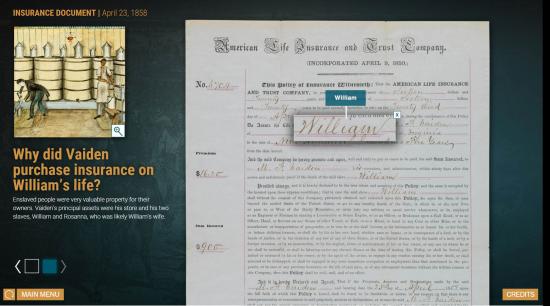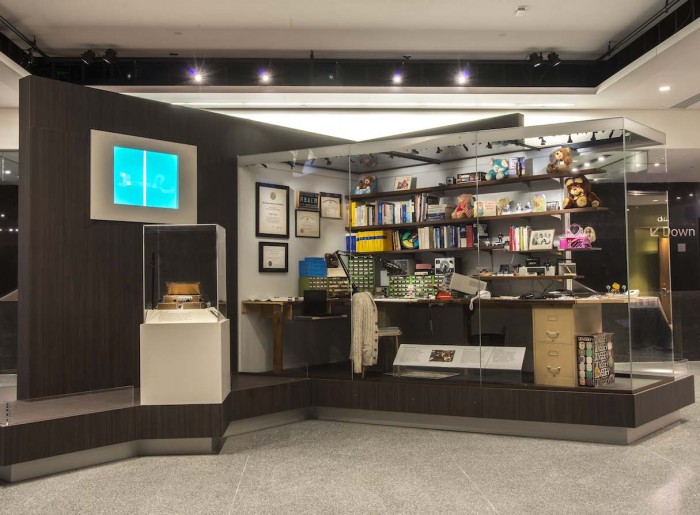American Enterprise: The story of labor and power, success and failure, and the rise of the global economy
A new exhibition at the American History Museum chronicles the story of how the United States grew from a small, dependent, agricultural nation to one of the world’s most vibrant economies. American Enterprise is the largest of 13 exhibitions and program spaces that will occupy the 45,000 square foot Innovation Wing on the first floor of the museum. Jordan Grant, a New Media Assistant working with the exhibition, spoke with David Allison, director of curatorial affairs at MAH and the exhibition’s project director, to learn about what makes American Enterprise unique.

The global era section of the “American Enterprise” exhibit documents the time period between the 1980s and 2010s. In the exhibition’s Exchange section, visitors of all ages can try to manage a farm, run a cat food business, resolve tough ethical dilemmas, and scale the tower of business success through cooperation or competition. (Photo courtesy National Museum of American History)
Why did the museum create an exhibition on the history of business?
Probably a better question is “Why hasn’t the museum done an exhibition on business history before?” Every American is deeply involved in business activities: in what they do for a living, where they live, and what they buy and consume. So it really is surprising that this is the first exhibition we have mounted that focuses specifically on American business and the economy.
Our museum was founded in 1964 as the Museum of History and Technology. We became the Museum of American History in 1980. So traditionally we emphasized the development of new ideas and innovations in our exhibitions. Often we carried the story to product development, but rarely did we look at the story from the perspective of workers and consumers as we now do in American Enterprise. Innovation is still a big part of our story, but by treating it in the context of American business as a whole, we provide a broader and deeper look at how American business shapes American life than we have ever done before.

The entrance to American Enterprise includes an interactive wall where visitors can learn more about the people, objects, and ideas featured in the exhibition.
Some museum visitors might expect that an exhibition on the “history of business” would be pretty dry. How did the exhibition team try to overcome this stereotype?
Since this was the Smithsonian’s first exhibition on the history of business, relevance to our visitors was a major goal. This exhibition was years in planning, and the curators, designers, educators, and project developers who put it together paid close attention to crafting the myriad details of the exhibition. It is full of great objects, stories about interesting people, and lots of interactive experiences. Our goal was to make it engaging, thought-provoking, and meaningful for audiences of all ages and interests, from both the United States and around the world.
Business and economic history traditionally focus on businesses themselves: how they were formed, how they operate, how they earn or lose money. To make our exhibition relevant to all visitors, however, we thought it needed to focus as much on consumers as on producers; as much on workers as on managers; as much on ordinary life experiences with business as on the innovations and breakthroughs that have been the sources of fundamental historical change. We wanted to show how producers and consumers interact in marketplaces, and how marketing and advertising mediate between what businesses make and what consumers buy.

Mr. Peanut is among the advertising icons featured in the American Enterprise exhibition. (Photo courtesy of the National Museum of American History)
So as we chose objects to exhibit, we included many from everyday life experiences: shoes, gloves, tea cups, a Monopoly game, a refrigerator stuffed with common food items, popular phonograph records, and electronic devices that have faded into the past. These stand beside some of the Smithsonian’s treasured artifacts, such as Eli Whitney’s cotton gin model, Thomas Edison’s light bulb, Alexander Bell’s telephone, and a 1918 Fordson Tractor. We even have a piece of Google’s first computer server. We hope this blend of objects will help visitors see their own personal story linked to a larger national narrative about the history of United States economic development from the 1770s to the present. We hope they will say, “We had one of those,” or “That reminds me of something I saw in my grandparents’ house!” Much of our intent is to help people discover the stories behind the objects that have touched their lives.

This aqua Hotpoint refrigerator, a common appliance in American kitchens in the late 1950s, is in our “American Enterprise” exhibition. (Photo courtesy of the American History Museum)
Besides these amazing objects, what will visitors find in the exhibition?
Our audience studies tell us that our visitors come to us with one or more of four basic interests: ideas, objects, people, and interaction, and that a successful exhibition must integrate all of them. We have worked to mix them all together in American Enterprise. As visitors enter the exhibition, they will find a touch wall where they can interact with images of people, objects, and ideas that they’ll find throughout the exhibition. They’ll also find some surprise effects if they touch the images and boxes on the screen more than once! This is an appropriate introduction, because throughout the exhibition, visitors will be challenged to explore the ideas that underlie the history of American business, the people who were key actors and agents of change, and original artifacts that were integral elements of historical moments. People will also be able to interact with over sixty electronic or mechanical displays to explore many topics more deeply. Besides giving visitors choice, we gave them variety by continually changing the form and style of our presentation.

One of several interactives within the American Enterprise exhibit. Spin a wheel and try to get to the top of the Tower of Power. (Photo courtesy of the National Museum of American History)
Does the American Enterprise exhibition have a big idea or takeaway—something you would like all visitors to learn during their visit?
We organized our exhibition around key themes, which you will find echoed in the labels and interactive content in the exhibition. Our overarching goal was to explore what we thought was particularly characteristic about business in America. We concluded that American distinctiveness came from the dynamic relationship in our nation between capitalism and democracy. As a nation, we are fully committed to supporting both. The capitalist system propels our economic development, while democratic government modulates and regulates economic change and its social impact. This dynamic relationship at the national level is mirrored in our individual lives by a balance between our seeking individual opportunity and advancement on the one hand, and our commitment to supporting the common good on the other. We Americans consider the best citizens those who not only succeed in their own lives, but also help others and work for the betterment of society as a whole.

More than 60 interactive displays will give visitors an opportunity to dig deeper into the exhibition’s major ideas and themes. This particular screen is part of a section entitled the “Business of Slavery,” which examines the economic dimensions of slavery and reflects on the institution’s social and personal costs.
Within this general context, we focused on four topics: opportunity, innovation, competition and a concern for common good. They are highlighted continually in the stories and descriptions of people, objects, and events that make up the body of the exhibition. Our visitors will find that overall, the exhibition is a blend of achievements, mistakes, and unintended consequences—of high points and low points in American history. We know that the development of American business has always been multifaceted and complex. And as we point out in a series of “Debating Enterprise” panels, leaders throughout history have disagreed on how the economy should be managed, just as they continue to do today.
The exhibition is not intended to convey a single thesis or conclusion about American business. Rather it is intended to be an engaging and thoughtful environment for people to explore this topic in three dimensions, informed by authentic objects, powerful graphics, and compelling interactive displays. If we have helped our visitors get more engaged in this subject, given them new perspectives, and spurred them to want to learn more, then we have achieved our goal.

The personal workshop of Ralph Baer, considered the Father of the Video Game in the American Enterprise exhibit. (Photo courtesy of the National Museum of American History.)
What are your hopes for the American Enterprise exhibition?
The fundamental purpose of history is to examine and better understand social change. In an exhibition, this learning is less conceptual than experiential. We know that people come to an exhibition to see and experience more than to read and think, so we invite our visitors to pay attention to the visual and sensual features of our exhibition as you go through. Notice how we endeavored to enrich our presentations by using space, color, light, juxtaposition of objects and images, size and scale, and interactive explorations. Reflect on how our environment takes you through hundreds of years of historical change that impacts your life every day. In sum, we hope that visiting the exhibition will help our visitors achieve our museum’s mission of understanding the past to make sense of the present and shape a more humane future.
A version of this post was originally published by the American History blog, “O Say Can You See?”
Posted: 2 July 2015
-
Categories:
American History Museum , Feature Stories , History and Culture , News & Announcements




[…] National Museum of American History reopened the first floor of its renovated west wing July 1. It celebrates America’s innovative spirit by offering more than a dozen exhibitions, […]